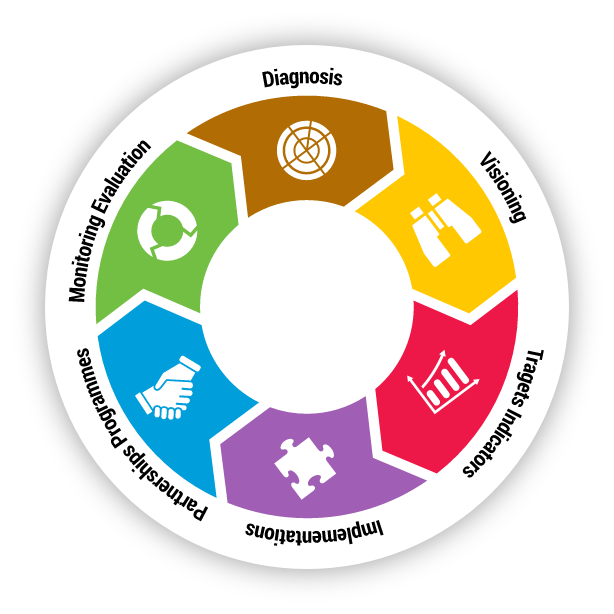Building new and leveraging existing partnerships and programs is important when developing a sustainable freight transport strategy. As freight transport transcends transport modes, geographical borders and jurisdictions, it is critical to ensure multijurisdictional and multi-stakeholder collaboration while developing sustainable freight transport strategies.
Partnerships
A starting point when developing partnerships in the freight transport sector is to liaise with relevant policy makers and ministries (transport, finance, trade, customs, infrastructure, etc.) and to leverage existing associations, industry groupings, chambers of commerce, and leading logistics and freight transport operators. Typically, leaders within these organisations are familiar with the members of the freight transport community and may be able to lead partnership-building efforts.
The benefits of partnerships in support of sustainable freight transport are manifold. For example, they can help:
- Address the problem of insufficient/limited data/information relating to sustainable freight transport. There is a need to gather more and better quality and more reliable data and information on the state of the freight transport sector as well as its sustainability.
- Facilitate private sector involvement and acceptance and rally political support for freight transport and sustainable freight transport-related projects. A broad coalition may help to raise funding and to place it higher on the political agenda, which may lead to faster progress.
- Ensure better coordination of competing and overlapping priorities and planning (at local/national/regional levels). Agencies with stakes in freight transport tend to operate independently from one another and often with different priorities. As several interest areas overlap, the coordination of interagency work constitutes an important challenge. Partnerships could prove helpful in this respect.
- Learn from others. Draw upon successful approaches and experiences from around the world and gain knowledge about relevant issues.
- Help generate support and funding for relevant and promising projects. In general, the freight transport sector receives funding from both the public and private sectors. However, given budget constraints and the competing priorities, including from within and outside the freight transport sector, funding earmarked for the freight transport sector may be limited.
- Develop policies, regulation, legislation, financing mechanisms (both comprehensive and specific) to support the freight transport sector and its sustainability. Knowledge from industry, research and civil society will make the legislation better.
- Encourage and brand efforts by the private sector. Highlighting private sector engagement may lead to further investment in sustainable freight transport.
- Promote the strategic role of the freight transport sector as an economic competitiveness factor. If a wide range of stakeholders confirms its central role for economic development, this may help in raising funds and political support.
Thus, well-designed and effective partnerships in support of sustainable freight transport, allow stakeholders to gain a better understanding of their respective constraints and obligations as they provide a forum where experiences, views, information, data and good practice in the field of sustainable freight transport could be shared. Such forums help government, businesses, freight transport operators, environmental groups, private sector associations, local communities and other interested stakeholders to work together to address common issues faced when addressing the sustainability of the freight transport sector. Partnerships can help address the challenge associated with developing and implementing a sustainable freight transport strategy, while allowing for a tailored approach that takes into account the specific local conditions, constraints, and opportunities.
Programmes
In addition to setting up partnerships, adopting a pragmatic approach is often required for successful implementation of sustainable freight transport strategies. This is because, programmatic approaches build on existing efforts and platforms and dedicated programmes that integrate diverse strategies, policies, and investments to achieve a desirable vision. Freight transport programmes and initiatives are often proposed to help:
- Improve fuel efficiency across the supply chain, thus lower costs and reduce GHGs.
- Ensure adequate freight transport infrastructure and services.
- Harmonise standards.
- Lower emissions of air pollutants.
- Increase collaboration between and among, governments, shippers, and carriers to support the use of clean and fuel-efficient technologies, information and communications technologies (ICT), and, Intelligent Transport Systems (ITS).
- Promote intermodality.
- Make the freight transport sector more socially inclusive.
- Improve access to sustainable freight transportation.
- Increase public recognition of efforts made to advance sustainable freight transport.
- Improve customer perception.
Existing freight transport programmes vary and need to be tailored based on the findings of relevant visioning and diagnosis work. Key objectives, targets, and timelines need to be developed and supported by ensuring a clear governance structure and mechanism.
By using a programmatic approach, a successful sustainable freight transport programme is able to grow horizontally and vertically over time (i.e. new components, more stakeholders, more activities are added over a period of time). Experience suggests that sustainable freight transport programmes should not be designed in full and at once. Instead, they should be developed gradually and in steps. Each new component throughout this process should be supported by studies and activities that take into account existing gaps to be addressed and reflect the needs of government and other stakeholders.
Sustainable freight transport programmes enable a structured relationship between government agencies and private sector entities seeking to address freight transport externalities and enhance the sustainability of the sector. In principle, sustainable freight transport programmes should cover all possible modes of freight transport, maximise the potential for intermodal freight transport efficiencies and ensure greater use of more efficient modes. These programmes can be extremely successful at a relatively low cost and their establishment process creates coalitions of stakeholders that are valuable resources in themselves.

